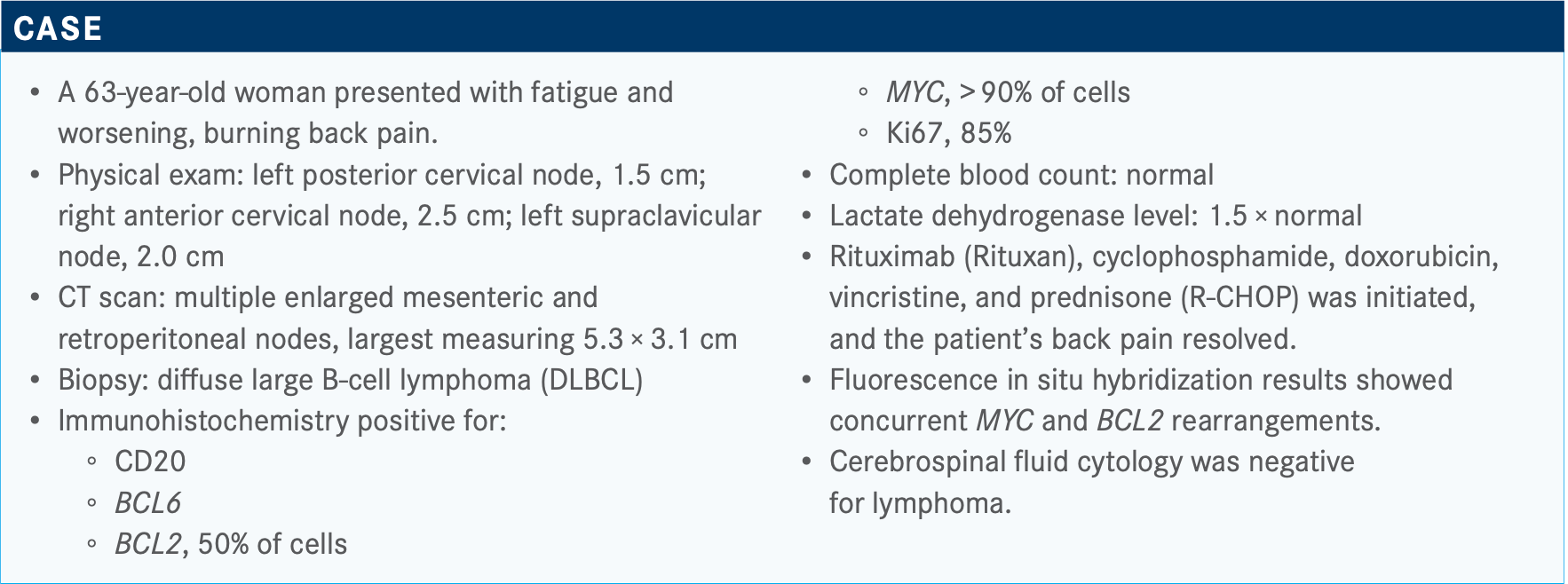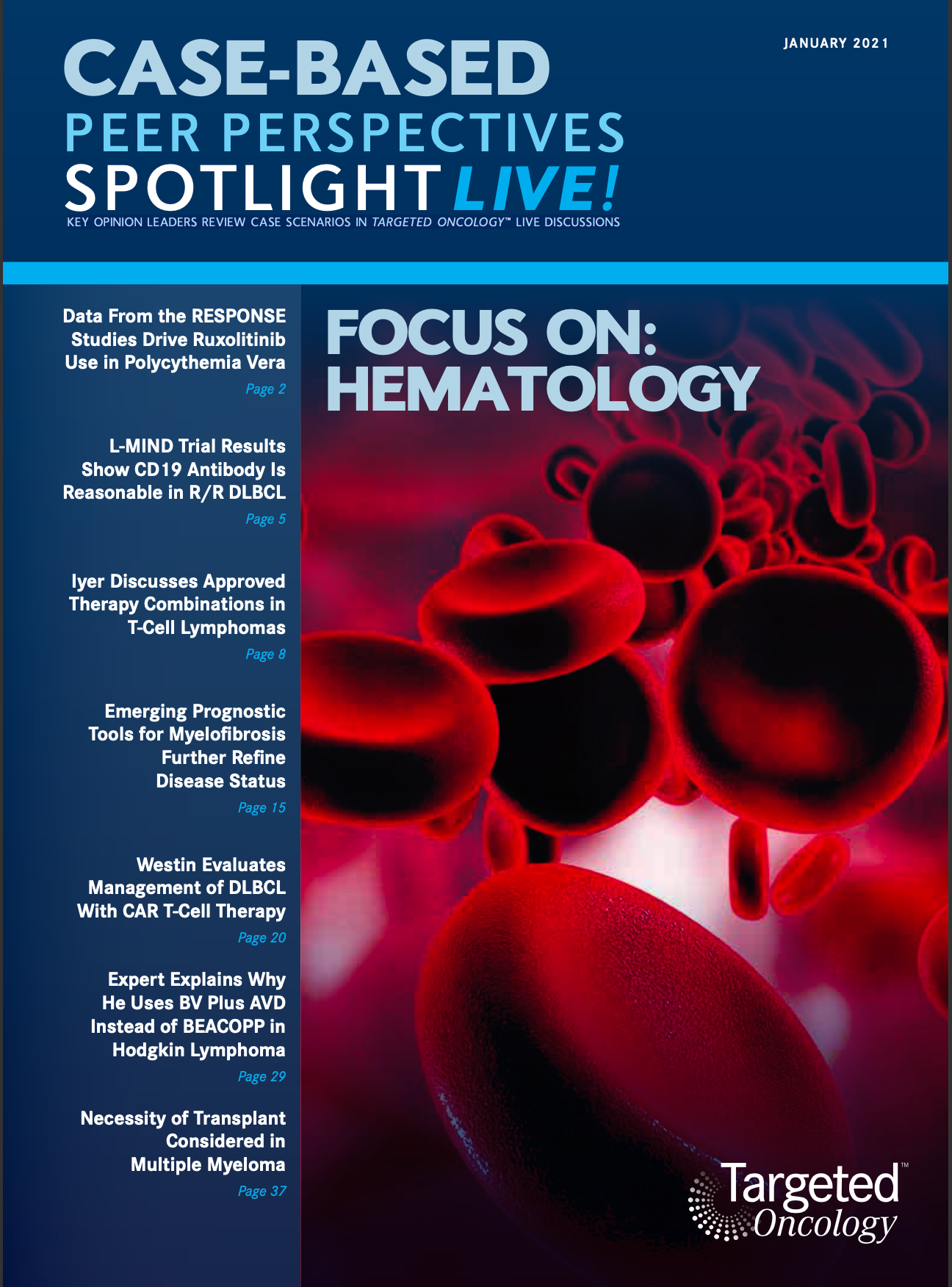Westin Evaluates Management of DLBCL With CAR T-Cell Therapy
During a Targeted Oncology Case-Based Peer Perspectives virtual event, Jason Westin, MD, MS, evaluated the management of a 63-year-old patient with diffuse large B-cell lymphoma.
Jason Westin, MD, MS

During a Targeted Oncology Case-Based Peer Perspectives virtual event, Jason Westin, MD, MS, director, Lymphoma Clinical Research, section chief, Aggressive Lymphoma, and associate professor, Department of Lymphoma/Myeloma, Division of Cancer Medicine, The University of Texas MD Anderson Cancer Center, evaluated the management of a 63-year-old patient with diffuse large B-cell lymphoma (DLBCL).

Targeted OncologyTM: What is your initial impression of the therapy used in this case? How would you treat the patient?
WESTIN: There’s not a right or wrong approach here. We don’t have any randomized data yet saying that R-CHOP is clearly wrong. We have data from retrospective [analyses] from MD Anderson Cancer Center, as well as a cooperative group publication, saying that outcomes appear inferior with R-CHOP versus R-EPOCH [rituximab, etoposide, prednisone, vincristine, cyclophosphamide, and doxorubicin]. But there are all types of biases when choosing to treat with R-CHOP for that patient—is it because she was older and frail and couldn’t tolerate EPOCH? [It’s not a surprise that] elderly and frail patients don’t live as long as patients who are more fit. Sometimes those kind of analyses have biases built into them that might favor the more aggressive treatment, just because of whom you’re choosing to give it to. But I think most people feel that if the patient is able to tolerate a change in treatment, at least try it, at least see whether they’re able to tolerate R-EPOCH.
For many patients, R-EPOCH is not that much more toxic than R-CHOP. It’s the same drugs; etoposide is added and stretched over 5 days, basically continuous infusion for the first 4 days and then the cyclophosphamide on day 5. It is the same dose for CHOP. So it’s more complicated for oncologists to give than the [regimen of] 1 day every 3 weeks in the infusion area. But in terms of patients, the adverse effects [AEs] generally line up to be similar. I also...give CNS [central nervous system] prophylaxis. Patients with double-hit lymphoma have a higher risk of CNS disease. It’s not through the roof, but the incidence is usually somewhere in the 10% to 20% range of patients who could have a relapse in the brain.
How do you prefer to give patients CNS prophylaxis?
There’s no wrong answer, so whatever you like to use is OK. Many people use intrathecal [IT] chemotherapy because it’s easier than having to stop CHOP and give methotrexate—what if there’s renal dysfunction, or what if the liver function tests [get worse], and then you have to delay the next cycle?
For EPOCH, cytopenias are sometimes a challenge in that second week when you’re trying to give somebody IT or intravenous [IV] methotrexate. Many people would give it as concurrent IT with EPOCH. There were data from the 2020 American Society of Hematology annual meeting that IT and IV might not [make a difference in AE recurrence].1 There was a large meta-analysis from multiple sites across the United States and internationally showing that for patients who are at high risk of CNS relapse, whether they receive treatment via IT or IV, both [delivery methods] still have a high risk of relapse in the brain. This is totally controversial, and the [definitive] answer is that we don’t know.
Most people will continue to use IT or IV methotrexate. You just want to make sure if you’re giving IV that you’re maintaining the schedule and dosing intensity for the systemic chemotherapy, that you’re not compromising and [there are] 5 weeks between doses of EPOCH so you can give them methotrexate in the middle.
What other regimens besides EPOCH are being used in this setting?
There are places around the world that don’t use EPOCH. They use hyper-CVAD [cyclophosphamide, vincristine, doxorubicin, dexamethasone] or CODOX-M [cyclophosphamide, vincristine, doxorubicin, high-dose methotrexate]. In the United States, EPOCH [in] publications from the National Cancer Institute from Wyndham Wilson, MD, PhD, and Kieron Dunleavy, MD, showed good results in the mediastinal subtype and some patients with Burkitt lymphoma; I’ve shifted over to using it.
EPOCH is a fairly widely used regimen, but it’s not [wrong to use] hyper-CVAD, CODOX-M, or the intensified regimen from Europe. It’s basically [moving up] from R-CHOP to something more intense.

Which trials are relevant right now for the population with DLBCL?
Axicabtagene ciloleucel [axi-cel (Yescarta)] was the first CAR [chimeric antigen receptor] T cell approved for adults with DLBCL in the United States, based on the pivotal trial [ZUMA-1 (NCT02348216)].2 [Eligible patients had] no response to last chemotherapy or relapse less than 12 months after autologous stem cell transplant, so basically patients with refractory disease or who were relapsing post transplant. They had to have [received] a prior [anti-CD20 therapy] and a prior anthracycline, which most patients with DLBCL have had.
The trial enrolled 108 patients in 2 cohorts. The [cohort] we’ll focus on is the DLBCL cohort. Generally, the schema for CAR T cells [is] a lymphodepleting chemotherapy that’s given ahead of time—cyclophosphamide and fludarabine. This is to help the T cells grow, not to control disease; this is to get a favorable cytokine and microenvironment for cell growth when those T cells are infused. These are autologous cells. It’s a 1-time treatment of 2 × 106 CAR T cells, and in this trial, 99% of patients who were enrolled were able to [have their cells] manufactured and 91% were dosed with the cells.
This [study is] changing our management of disease for patients because the overall response rate [ORR] was 83% and 58% had a complete response [CR].3 In this population post transplant or in those who are refractory to heavy-duty chemotherapy, there is a progression-free survival [PFS] of 5.9 months. There was a [significant] proportion of patients who otherwise probably would have died of their disease.
What other CAR T-cell therapies are available?
The second CAR T-cell therapy that was approved for adults with DLBCL, tisagenlecleucel [tisa-cel; Kymriah], was based on findings of the pivotal JULIET study [NCT02445248].4 This schema was basically the same for all the CAR T-cell therapies where patients undergo apheresis, which is similar to but not the same for transplant apheresis. This is [for patients] not getting CD34-positive cells...giving T cells that are cryopreserved for tisa-cel. They’re then shipped to manufacturing. Patients could get bridging therapy on this clinical trial, which was not the case for the ZUMA-1 trial. They had undergone lymphodepletion with chemotherapy for 5 days, 4 days, and 3 days before receiving the infusion of the CAR T cells on day 0, and then they’re followed.
The results of this clinical trial [showed] ORR was a little lower at 52% and CR rate at 40% [compared with ZUMA-1]. But for those with a CR, there was an impressive Kaplan-Meier curve that showed patients being a year or more out, and 80% or more of them are holding their response. Median overall survival was 12 months for patients who were infused on this study.
How do the available CAR T-cell therapies compare?
Comparing the 2 products I just mentioned that are already FDA approved, as well as the one with impending approval, lisocabtagene maraleucel [liso-cel]...there was fairly robust follow-up now, 27 months, 14 months, 18 months [with axi-cel, tisa-cel, and liso-cel, respectively]; we’re seeing median PFS level out around 6 months.3-5 We see the same plateau occur in all these CAR T-cell studies, where there’s a proportion somewhere in the 30% to high 40% range of patients who are long-term responders. With tisa-cel and liso-cel, the median overall survival was 12 months and 21 months, respectively; for axi-cel, it’s not reached, which is awfully impressive for this otherwise refractory population.
The trade-off is that it works but can be toxic. The cytokine release syndrome that people talk about, which is the dreaded complication, was seen in the studies at relatively low frequency and was characterized as grade 3 or 4. The tisacel grade 3/4 AEs were higher [23%], but it used a different grading system than the other 2. If [the AEs were] graded with the same system, it was pretty similar, around 10% or so. All 3 of them have an incidence of grade 3 or 4 cytokine release syndrome, but it’s relatively infrequent. The neurotoxicity is different, however, and for axi-cel, about 1 in 3 patients will have grade 3 or 4 neurotoxicity, which is sometimes prohibitive for this being utilized outside specialized centers that do this frequently. These are some of the reasons that it can be a challenge to administer these drugs.
What other kinds of drugs are available in this setting, and what data support them?
Another option approved recently is polatuzumab vedotin [Polivy], an antibody-drug conjugate, plus bendamustine and rituximab [BR].6 Approval was based on a randomized phase 2 trial for patients with relapsed disease, and it was randomized to either BR or polatuzumab/BR. Patients could not receive [this regimen] after transplant, either allogeneic or autologous, if they had significant neuropathy or if they were eligible for autologous transplant.
The patients’ ages were typical for this population. The International Prognostic Index score was fairly well balanced, although it was a bit higher risk in the BR arm. The median number of prior lines of treatment was 2 in both arms and about the same for the proportion of patients who had more than 3 prior lines. Seventy-five percent of patients [in the polatuzumab arm] and 85% [in the BR-only arm] had been refractory to the most recent therapy, [so this was a] highly refractory group. The germinal center B-cell subtype was fairly even between these groups.
Polatuzumab had an objective response rate of around 45% and a CR rate of 40%. Bendamustine is not the best drug combination for patients, [and BR had a] 17.5% objective response rate.
The PFS was statistically significant, 9.5 versus 3.7 months for the investigator review as well as the central review [HR, 0.36; 95% CI, 0.21-0.63; P < .001]. Every subgroup favored the polatuzumab/BR regimen.
Bendamustine has toxicities, but polatuzumab/BR has a bit more in terms of the cytopenias. Neutropenia was more common. Febrile neutropenia was fairly even. A bit more neutropenia but not more febrile neutropenia. Then the peripheral neuropathy, which we know from this drug class...is an issue. Not so much with bendamustine, but about 40% of patients had some degree of mild neuropathy on the polatuzumab side.
Have there been other approvals in this setting?
Selinexor [Xpovio] was approved [in 2020 based on results of the SADAL] trial [NCT02227251].7 This evaluated patients with relapsed DLBCL who were transplant ineligible. They had to be at least 60 days post treatment or 14 weeks if they had less than a partial response. So this was not a refractory population.
The response rates [were] 28% ORR, 12% CR, and it’s fairly similar across the different cell of origin subtypes. There was a good group of patients who got some benefit even if they didn’t get a CR, and there’s no patient variable that came out as a predictor for response.
Treatment AEs [included] thrombocytopenia as the big one. It was basically 60% or so of patients have some degree of thrombocytopenia; 15%, grade 4. About half the patients had some nausea, some anorexia, and some weight loss. Seventeen percent of patients discontinued because of treatment AEs, and 5 patients died because of treatment AEs.
REFERENCES:
1. Bobillo S, Joffe E, Seshan V, et al. Central nervous system prophylaxis with high-dose intravenous methotrexate or intrathecal chemotherapy in patients with diffuse large B-cell lymphoma and high-risk of CNS relapse treated in the rituximab era. Blood. 2019;134(suppl 1):1619. doi:10.1182/blood-2019-131435
2. Neelapu SS, Locke FL, Bartlett NL, et al. Axicabtagene ciloleucel CAR T-cell therapy in refractory large B-cell lymphoma. N Engl J Med. 2017;377(26):2531-2544. doi:10.1056/NEJMoa1707447
3.Locke FL, Ghobadi A, Jacobson CA, et al. Long-term safety and activity of axicabtagene ciloleucel in refractory large B-cell lymphoma (ZUMA-1): a single- arm, multicentre, phase 1-2 trial. Lancet Oncol. 2019;20(1):31-42. doi:10.1016/ S1470-2045(18)30864-7
4. Schuster SJ, Bishop MR, Tam CS, et al; JULIET Investigators. Tisagenlecleucel in adult relapsed or refractory diffuse large B-cell lymphoma. N Engl J Med. 2019;380(1):45-56. doi:10.1056/NEJMoa1804980
5. Abramson JS, Palomba ML, Gordon LI, et al. Lisocabtagene maraleucel for patients with relapsed or refractory large B-cell lymphomas (TRANSCEND NHL 001): a multi- centre seamless design study. Lancet. 2020;396(10254):839-852. doi:10.1016/ S0140-6736(20)31366-0
6.Sehn LH, Herrera AF, Flowers CR, et al. Polatuzumab vedotin in relapsed or refractory diffuse large B-cell lymphoma. J Clin Oncol. 2020;38(2):155-165. doi:10.1200/ JCO.19.00172
7. Kalakonda N, Maerevoet M, Cavallo F, et al. Selinexor in patients with relapsed or refractory diffuse large B-cell lymphoma (SADAL): a single-arm, multinational, multicentre, open-label, phase 2 trial. Lancet Haematol. 2020;7(7):e511-e522. doi:10.1016/S2352-3026(20)30120-4

Survivorship Care Promotes Evidence-Based Approaches for Quality of Life and Beyond
March 21st 2025Frank J. Penedo, PhD, explains the challenges of survivorship care for patients with cancer and how he implements programs to support patients’ emotional, physical, and practical needs.
Read More